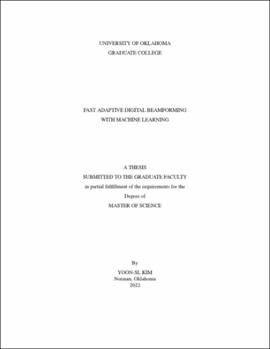| dc.description.abstract | Digital polarimetric Phased Array Radar (PAR) has the potential to achieve high temporal and spatial resolution needed for next-generation weather observations. It offers flexibility in scanning strategies, including the use of electronic steering, coupled with traditional "pencil" beams, spoiled beams, and/or multiple beams. Digital beamforming (DBF) is one of the unique capabilities of PAR used to simultaneously form multiple beams digitally, a critical capability needed to improve temporal resolution. DBF can be done with non-adaptive or adaptive methods. The Fourier method pre-computes the beamforming weights based on the configuration of the antenna elements, which results in fixed sidelobe levels and angular resolution. In contrast, the Capon method computes the beamforming weights adaptively from receive signals. The Capon method can provide enhanced angular resolution over the Fourier method by lowering antenna sidelobe levels in directions with strong contaminating returns. However, it is challenging to implement the Capon method in real-time as the number of antenna elements grows due to the high computational cost.
This work proposes a computationally efficient Deep Learning Adaptive digital beam Forming (DLAF) method using a neural network trained with time-series IQ signals as input and the Capon beamforming weights as output. The network is built with a combination of convolution, activation, normalization, and dense layers. The novelty of the proposed network is that it implements an AI-based adaptive beamforming method preserving signal phase information, which improves the efficiency and accuracy of the learning. The proposed DLAF model is evaluated using a simulated point target, an actual point target, and simulated weather signals for a planar digital array architecture. Specifically the performance of DLAF is evaluated and compared to both the Capon and Fourier methods. Two qualitative metrics used for the evaluation are the quality of the generated beam pattern, such as the half-power beamwidth, artifacts from sidelobes, and the capability of placing nulls at locations with strong interference signals. Four quantitative metrics used for the evaluation are computation time, the performance of DLAF as a function of SNR, mean squared error of beamforming weight values, and normalized cross-correlation of generated beam patterns. Preliminary results show that DLAF was trained successfully to perform adaptive DBF and mimic the behavior of the Capon method for point and distributed targets. Furthermore, DLAF can significantly reduce the computational time which allows real-time implementation of adaptive DBF. | en_US |

